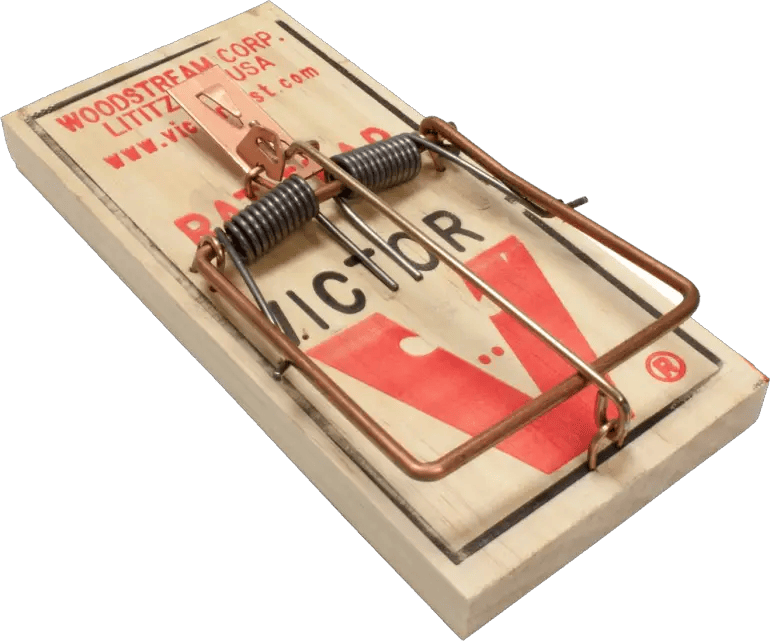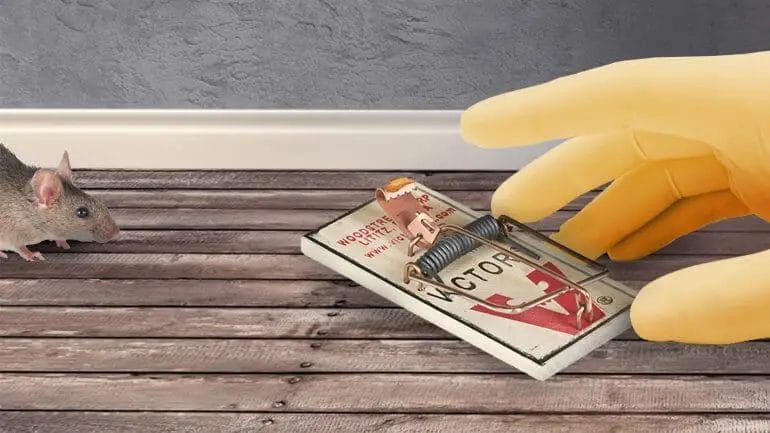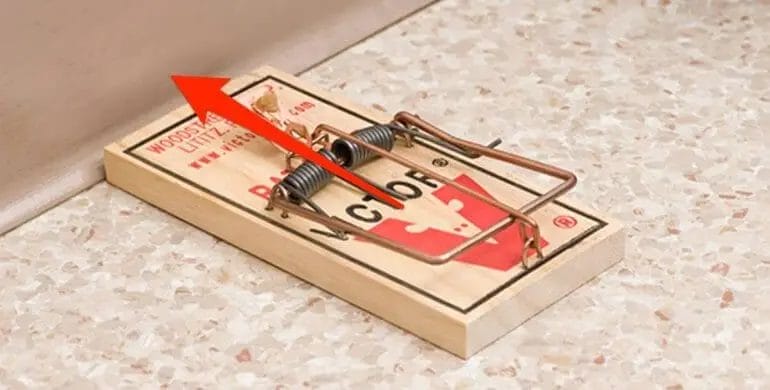Setting a wooden mouse trap can be a highly effective way to catch mice and keep your home free of these pests. The process is relatively straightforward and requires a few simple steps.
First, make sure you have a sturdy and reliable wooden mouse trap. These traps are typically made of wood, with a metal bar that snaps down when triggered by the mouse.

Next, place a small amount of bait on the trap. Peanut butter, cheese, or chocolate are all popular options that mice are attracted to.
Position the trap in an area where you have noticed mouse activity, such as along the baseboards or in a corner. Mice tend to follow the same paths, so strategic placement is crucial.
Finally, carefully set the trap by pulling the metal bar back and holding it in place with your fingers or a small object. Make sure the trigger mechanism is securely in place.
With your wooden mouse trap properly set, wait patiently for a mouse to take the bait and trigger the trap. Be sure to check the traps regularly and dispose of any caught mice promptly and safely.
Remember, setting a wooden mouse trap requires caution and attention to detail to ensure its effectiveness. By following these steps, you can successfully set a wooden mouse trap and keep your home rodent-free.

Step-by-Step Guide to Setting up a Wooden Mouse Trap
If you’re facing a mouse infestation problem in your home or office, setting up a wooden mouse trap can be an effective and humane way to get rid of these unwanted pests. In this section, we will provide you with a step-by-step guide on how to properly set up and use a wooden mouse trap.
Step 1: Gather the Necessary Supplies
Before you start setting up the mouse trap, make sure you have all the necessary supplies handy. Here’s a list of things you will need:
- A wooden mouse trap
- Bait (such as cheese or peanut butter)
- A small piece of string or wire
- Gloves (to protect your hands)
Step 2: Choose the Right Location
It’s important to place the mouse trap in the right location to maximize its effectiveness. Look for signs of mouse activity, such as droppings or chewed wires, and place the trap in those areas. Mice usually travel along walls and prefer to stay in hidden or dark corners, so be sure to place the trap against a wall.
Step 3: Prepare the Trap
Before setting up the trap, make sure it is clean and free from any dirt or debris. This will help prevent any unwanted scents that could deter mice from approaching the trap. Additionally, ensure that the trap is functioning properly and that the trigger mechanism is in working order.
Step 4: Apply Bait
Apply a small amount of bait, such as cheese or peanut butter, to the bait pedal of the mouse trap. The smell of the bait will attract mice and entice them to step on the pedal, triggering the trap. Be careful not to apply too much bait, as this can prevent the trap from activating properly.
Step 5: Set the Trap
Now it’s time to set up the trap. Pull back the spring-loaded metal bar and hold it in place with one hand. Place the small piece of string or wire through the hole on the metal bar and tie it securely. This will prevent the bar from snapping shut accidentally while you’re setting up the trap.
Once the string or wire is securely tied, place the baited pedal of the trap towards the wall, ensuring that it is facing outwards. Carefully release the spring-loaded bar, making sure it is resting on the bait pedal. The trap is now set and ready to catch any mice that come near.
Step 6: Monitor and Dispose
Regularly check the trap to see if it has caught any mice. If the trap has successfully caught a mouse, use gloves to remove the trap from the location. Be cautious while handling the trap to avoid any contact with the captured mouse.
Dispose of the captured mouse in a sealed plastic bag and place it in an outdoor trash bin. It’s important to sanitize the trap before reusing it or storing it away to maintain its effectiveness.
Step 7: Prevent Future Infestations
To prevent future mouse infestations, it’s important to seal any entry points that mice can use to access your home or office. This includes sealing cracks and gaps in walls, doors, and windows. Keep your living or working space clean and free from food debris. Regularly empty trash bins and store food in tightly sealed containers.
In summary, setting up a wooden mouse trap requires gathering the necessary supplies, choosing the right location, preparing the trap, applying bait, setting the trap, monitoring and disposing of any caught mice, and taking preventive measures to avoid future infestations. Following this step-by-step guide will help you effectively get rid of mice and keep your space rodent-free.

Tips and Tricks for Baiting a Wooden Mouse Trap for Maximum Results
When it comes to getting rid of mice, using a wooden mouse trap can be an effective and affordable solution. However, simply setting up the trap may not always guarantee success. Baiting the trap correctly plays a crucial role in attracting mice and ensuring maximum results. In this section, we will provide you with some useful tips and tricks for baiting a wooden mouse trap to achieve the best possible outcome.
1. Choose the Right Bait
The type of bait you use can greatly influence your trap’s success. Mice are attracted to certain scents and flavors, so it’s important to select bait that will appeal to their senses. Some popular options for mouse traps include:
- Peanut butter: Mice are known to be fond of the smell and taste of peanut butter. Applying a small amount on the trap’s trigger can be highly effective.
- Chocolate: Similar to peanut butter, chocolate has an enticing scent that mice find hard to resist. Smearing a small piece on the trap can entice them to take the bait.
- Cheese: Contrary to popular belief, not all mice are attracted to cheese. However, some mice do find the smell appealing, so it’s worth a try.
- Seeds or nuts: Mice are naturally drawn to seeds and nuts. Placing a few near the trap or attaching them to the trigger can entice them to investigate further.
Experiment with different types of bait to see which one works best in your specific situation. You can also try combining different bait options to increase the chances of success.
2. Use a Small Amount of Bait
When baiting a mouse trap, it’s important to remember that less is more. Avoid applying large amounts of bait as this can make it easier for mice to snatch it without triggering the trap. Instead, use a small pea-sized portion or a thin smear of bait on the trigger. This will force the mouse to apply more pressure, increasing the likelihood of a successful capture.
3. Secure the Bait
Mice are nimble and resourceful creatures, capable of stealing the bait without triggering the trap. To prevent this, it’s essential to securely attach the bait to the trap. You can use durable materials such as dental floss, fishing line, or even small zip ties to tie the bait tightly to the trigger. This will ensure that the mouse has to interact with the trap to access the bait, increasing the chances of a successful capture.
4. Position the Trap Strategically
Proper trap placement is crucial for effective baiting. Mice tend to follow specific travel paths and frequent areas near walls, corners, or entry points. Place the trap along these routes with the trigger facing the wall or the area where the mice are most likely to approach from. This will encourage them to explore the trap and increase the chances of a successful catch.
5. Set Multiple Traps
Setting up multiple traps can significantly improve your chances of catching mice. Place several traps in different areas where you have noticed mouse activity or signs of their presence. By doing so, you increase the likelihood of capturing multiple mice at once and reducing the population more effectively.
Remember to check the traps regularly and dispose of any captured mice in a safe and hygienic manner. By following these tips and tricks, you can enhance the effectiveness of baiting your wooden mouse traps and achieve optimal results in your quest to eliminate mice from your home.

Common Mistakes to Avoid When Using a Wooden Mouse Trap
Wooden mouse traps are a popular and effective method for catching mice. However, if not used correctly, they may not yield the desired outcome. To ensure successful mouse trapping, it is important to avoid these common mistakes:
1. Using the wrong bait
The bait you use in your wooden mouse trap plays a crucial role in attracting the mice. Many people make the mistake of using the wrong type of bait or not using any bait at all. It is important to use a bait that mice find irresistible, such as peanut butter or cheese. Avoid using strong-smelling baits that can easily be stolen without triggering the trap.
2. Placing the trap in the wrong location
The location of your wooden mouse trap is key to its success. Placing it randomly around the house may not yield the desired results. Mice tend to follow specific routes, such as along walls or baseboards. It is recommended to place the traps along these common pathways to increase the chances of catching a mouse.
3. Insufficient number of traps
Using only one trap may not be enough to effectively catch mice, especially if you have a significant infestation. It is important to place multiple traps in strategic locations to maximize your chances of catching the mice. Aim to set up at least four to six traps in areas where you have noticed mouse activity.
4. Failure to check the traps regularly
Once you have set up your wooden mouse traps, it is essential to regularly check them. Many people make the mistake of setting traps and forgetting about them for days. Checking the traps daily allows you to remove any captured mice promptly, preventing them from decomposing and causing unpleasant odors. It also enables you to reset the traps if necessary.
5. Incorrect trap placement
Placing the trap too close to walls or in areas where mice can easily avoid them is a common mistake. Mice are agile creatures and can easily navigate around obstacles. To increase the chances of catching a mouse, position the trap perpendicular to the wall with the trigger end facing away from the wall. This positioning forces the mouse to approach the trap from the front, increasing the likelihood of a successful catch.
6. Not securing the trap
It is crucial to secure the wooden mouse trap in place to prevent it from being moved or knocked over by the mouse. This can happen if the trap is not properly anchored or if the mouse is able to escape after triggering the trap. To ensure the trap stays in place, consider using tape or glue to secure it to a stable surface.
In summary, using a wooden mouse trap can be an effective method for catching mice. However, it is important to avoid common mistakes such as using the wrong bait, placing the trap in the wrong location, using an insufficient number of traps, failing to check the traps regularly, incorrect trap placement, and not securing the trap. By avoiding these mistakes, you can increase the chances of successfully trapping mice and keeping your home rodent-free.
Alternative Methods for Setting Wooden Mouse Traps in Different Areas of Your Home
If you are dealing with a mouse infestation in your home, one effective way to control the problem is by using wooden mouse traps. These traps are simple to set up and can help you catch and remove mice from your living spaces. In this section, we will explore some alternative methods for setting wooden mouse traps in different areas of your home.
1. Kitchen
The kitchen is one of the most common areas where mice are found, as they are attracted to food sources. To set up a wooden mouse trap in the kitchen, follow these steps:
- Identify the areas where mice are likely to travel, such as along baseboards or near food storage areas.
- Place the wooden mouse trap perpendicular to the wall, with the trigger end facing the wall.
- Bait the trap with a small amount of peanut butter or a piece of cheese. Mice are attracted to these strong-smelling foods.
- Make sure the trap is set and the trigger mechanism is engaged. Be cautious when handling the trap to avoid accidental activation.
- Put the trap in a safe location where it won’t be disturbed by pets or children.
- Check the trap regularly and dispose of any caught mice in a sanitary manner.
2. Basement
The basement is another area where mice often find shelter and nesting sites. To set up a wooden mouse trap in the basement, follow these steps:
- Locate areas where mice may enter the basement, such as cracks in the foundation or gaps around pipes.
- Set the wooden mouse trap near these entry points, ensuring that the trigger end is facing the potential mouse pathway.
- Bait the trap with food that mice are attracted to, such as chocolate or dried fruits.
- Check the trap regularly, as mice caught in the basement may have a higher chance of escaping due to the larger area.
- Dispose of any caught mice and take measures to seal off entry points to prevent further infestation.
3. Attic
The attic is often overlooked when it comes to mouse control, but it is a common area for mice to nest and hide. To set up a wooden mouse trap in the attic, follow these steps:
- Look for signs of mouse activity in the attic, such as droppings or chewed insulation.
- Place the wooden mouse trap in areas where mice are likely to travel, such as along beams or near stored items.
- Bait the trap with food that mice are attracted to, such as nuts or dried pet food.
- Ensure that the trap is set properly and the trigger mechanism is engaged.
- Regularly check the trap and remove any captured mice.
- Take steps to mouse-proof your attic by sealing any openings or cracks that may allow mice to enter.
4. Garage
The garage is another area that mice may frequent, especially if there are sources of food or shelter. To set up a wooden mouse trap in the garage, follow these steps:
- Identify areas where mice may be entering the garage, such as gaps around doors or windows.
- Place the wooden mouse trap near these entry points, with the trigger end facing the potential mouse pathway.
- Bait the trap with food that mice are attracted to, such as birdseed or sunflower seeds.
- Check the trap regularly and remove any captured mice promptly.
- Take measures to seal off any openings in the garage to prevent mice from entering.
In summary, using wooden mouse traps can be an effective way to control a mouse infestation in your home. By following the alternative methods outlined above, you can strategically set up traps in different areas of your home, increasing your chances of catching and removing mice. Remember to always handle traps with caution and dispose of captured mice in a sanitary manner.
Frequently Asked Questions
1. How do I set up a wooden mouse trap?
To set up a wooden mouse trap, follow these steps: 1) Place a small amount of bait, such as peanut butter or cheese, on the bait pedal. 2) Pull back the kill bar until it locks into place. 3) Set the trap in an area where you have noticed mouse activity, with the bait pedal facing a wall. 4) Release the kill bar and make sure it is properly set.
2. What is the best bait to use with a wooden mouse trap?
The best bait to use with a wooden mouse trap is something that mice find irresistible, such as peanut butter, chocolate, or small pieces of cheese. These strong-smelling foods will attract mice and increase the chances of them triggering the trap.
3. How often should I check the wooden mouse trap?
It is recommended to check the wooden mouse trap at least once a day. This allows you to remove any trapped mice and reset the trap if necessary. Checking the trap regularly ensures that it remains effective in capturing mice and helps prevent any unpleasant odors from decomposing rodents.
Conclusion
In conclusion, setting up a wooden mouse trap is a practical and effective solution for dealing with unwanted rodents. The simplicity and affordability of wooden traps make them a popular choice among homeowners. By following a few simple steps, you can enhance the trap’s efficiency and increase your chances of successfully catching mice.
Remember to choose an appropriate location for placing the trap, such as along walls or in areas where mice frequently traverse. Ensure the trap is properly baited with enticing food, such as peanut butter or cheese, to attract the mice. Regularly inspect and reset the trap as needed to maximize its effectiveness. By implementing these tips, you can successfully and humanely manage mouse infestations using wooden traps.